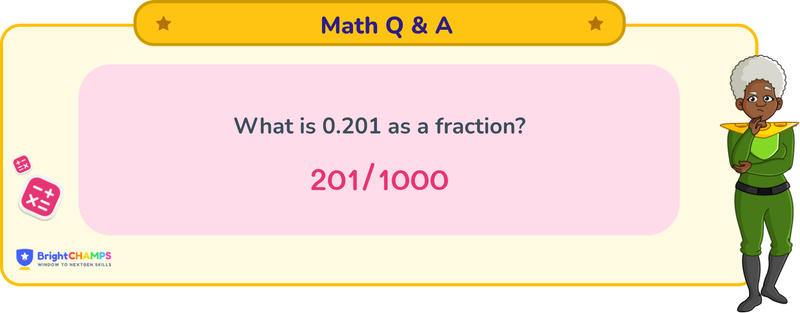Summarize this article:
 305 Learners
305 LearnersLast updated on August 5, 2025
0.201 as a Fraction

Numbers can be categorized into different types. Fraction is one of its kind. It is always represented in the form of p/q, where p is the numerator and q is the denominator. Fraction represents a whole and a fractional part. Decimals represent the fractional part of numbers. For example, 1/2, the numbers in decimal are expressed with a decimal point (.), For example, 0.201, we are going to learn how to convert a decimal to a fraction.

What is 0.201 as a Fraction?
 Answer
Answer
The answer for 0.201 as a fraction will be 201/1000.
Explanation
Converting a decimal to a fraction is a task for students that can be done easily. You can follow the steps mentioned below to find the answer.
Step 1: Firstly, any decimal number should be converted to a fraction for easy calculation. Here, 0.201 is the number on the numerator and the base number 1 will be the denominator. Then, 0.201 becomes 0.201/1.
Step 2: To remove the decimal from a fraction, you need to multiply both the numerator and denominator by 1000 (because there are three decimal places). 0.201/1 × 1000/1000 = 201/1000
Step 3: The fraction 201/1000 is already in its simplest form since 201 and 1000 have no common factors other than 1.
Thus, 0.201 can be written as a fraction 201/1000.

Important Glossaries for 0.201 as a Fraction
Fraction: A numerical quantity that is not a whole number, representing a part of a whole.
Decimal: A number that uses the base ten and includes a decimal point to separate the whole part from the fractional part.
Numerator: The top part of a fraction, indicating how many parts of the whole are being considered.
Denominator: The bottom part of a fraction, showing how many parts make up a whole.
Simplest Form: A fraction is in its simplest form when the numerator and denominator have no common factors other than 1.




